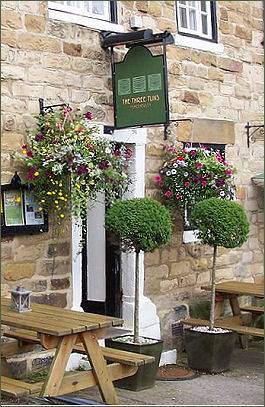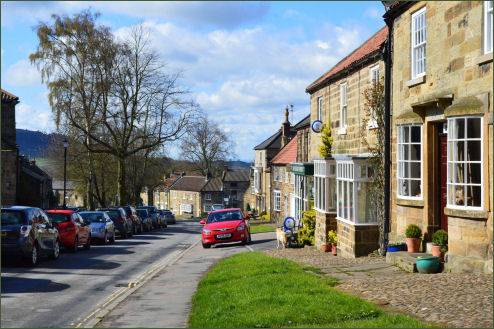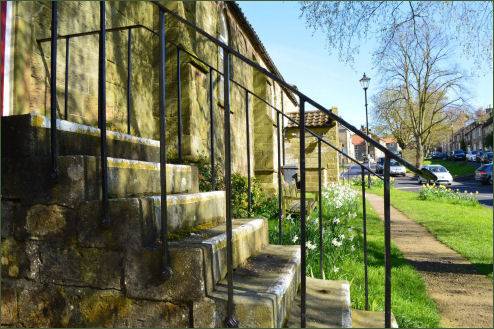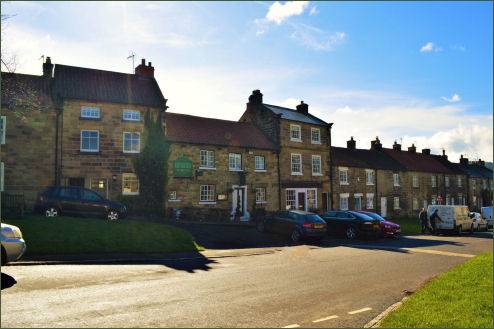Osmotherley
OS grid reference:- SE 456 972

 Osmotherley lies in the Hambleton hills, on the western edge of the beautiful North York Moors National Park. The attractive village is situated on the route of the 110 mile Cleveland Way National Trail and is the starting point for the famous 42 mile Lyke Wake Walk over the moors to the east coast at Ravenscar. Osmotherley is known as the walker's capital of the Moors.
Osmotherley lies in the Hambleton hills, on the western edge of the beautiful North York Moors National Park. The attractive village is situated on the route of the 110 mile Cleveland Way National Trail and is the starting point for the famous 42 mile Lyke Wake Walk over the moors to the east coast at Ravenscar. Osmotherley is known as the walker's capital of the Moors.
Osmotherley is interpreted as meaning the clearing or 'ley' of either a Viking called 'Asmund' or a Saxon known as 'Osmund'. There have been a number spellings of the name over the centuries.The name appears in the Domesday Book of 1086 as Asmundrelac; but has also been known as Osmundeslay and Osmonderlay.
Local legend states that the unusual name was acquired from the mother of a villager named Oswald or Osmund, who is said to have gone to gather firewood in the depths of winter. When she did not return her concerned son went to look for her and found her lying in the snow, dead or dying from the cold. Because he was not able to carry her back, he lay down beside her and died himself. Osmotherley supposedly marks the place where Oswald's mother lies.
Osmotherley boasts three pubs within a 55-yard (50 metre) radius, the Queen Catherine Hotel, the Three Tuns (pictured right) and the Golden Lion, which dates to the eighteenth century. All three serve meals and offer accomodation, there is also a variety of bed and breakfast establishments.
The village also has a Youth hostel, a village hall, a newsagents, a few shops including an antique shop and a walking shop selling outdoor provisions. In the centre of Osmotherley stands the old village cross and a stone barter table on five legs which was once used as a market stall.
The village church is dedicated to St Peter (pictured above left) and was largely rebuilt in 1892. It occupies the site of an earlier Saxon church and parts of the building dating from the Norman era.
In the church porch are displayed fragments of Saxon crosses and part of a hogback stone, the porch has marks of sharpening tools on its entrance. The Norman doorway has an arch with zigzag decoration and beak-heads, but two of its shafts have been replaced. The church font dates from the Norman period.


John Wesley preached at the barter table on the village green on several occasions, the first was in 1745. The Osmotherley Friends Meeting House, is a traditional stone building, erected in 1690 or 1723. Meetings are still held here once a month. Osmotherley is also home to the oldest Methodist chapel in the world, dating from 1754. It is thought that George Fox may have visited the village in the late seventeenth century.


Nearby is Cod Beck Reservoir, (pictured left) which derives its name from Cod Beck, a tributary of the River Swale. The beck acquires its name from the the old Brythonic Celtic word 'Coed', meaning wood. Sheepwash is a popular picturesque picnic spot to the north of the village, it was once a watering place on the ancient drovers' route over the moors to Yarm and the River Tees.


Mount Grace Priory, the best preserved of the ten medieval Carthusian houses in England, lies a few miles from the village. The priory was founded in 1398 by Thomas Holland, Duke of Surrey, the son of King Richard II's maternal half-brother Thomas, Earl of Kent, it was the last monastery to be established in Yorkshire. The priory is now owned by the National Trust but under the care of English Heritage.
The Shrine of Our Lady of Mount Grace, known locally as 'The Lady Chapel' overlooks the village, it was built by Carthusian monks from Mount Grace Priory in the fifteenth century.
